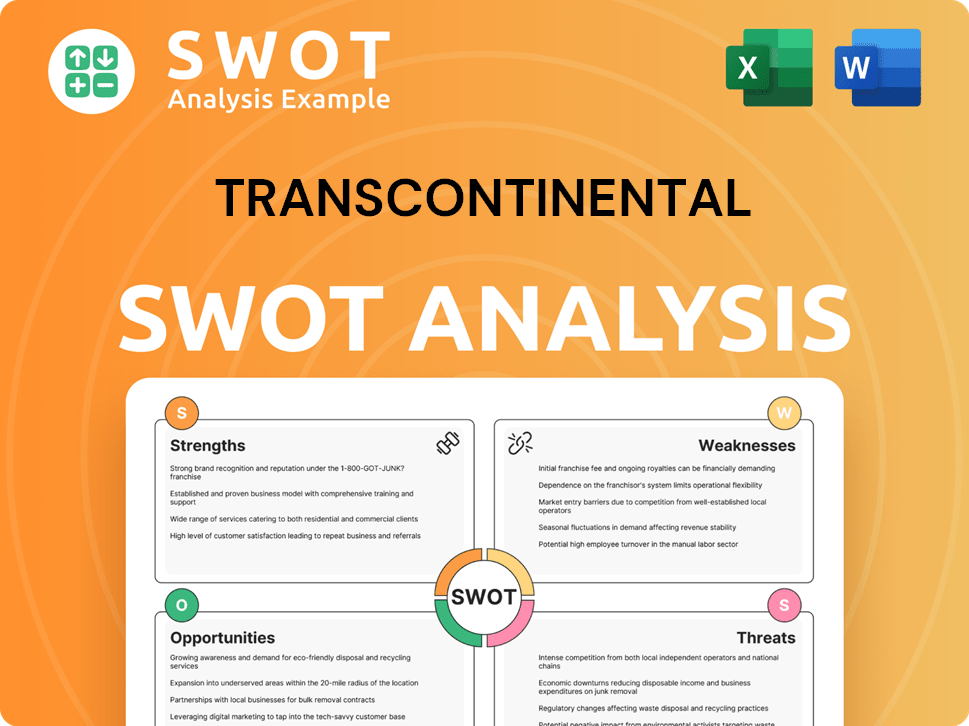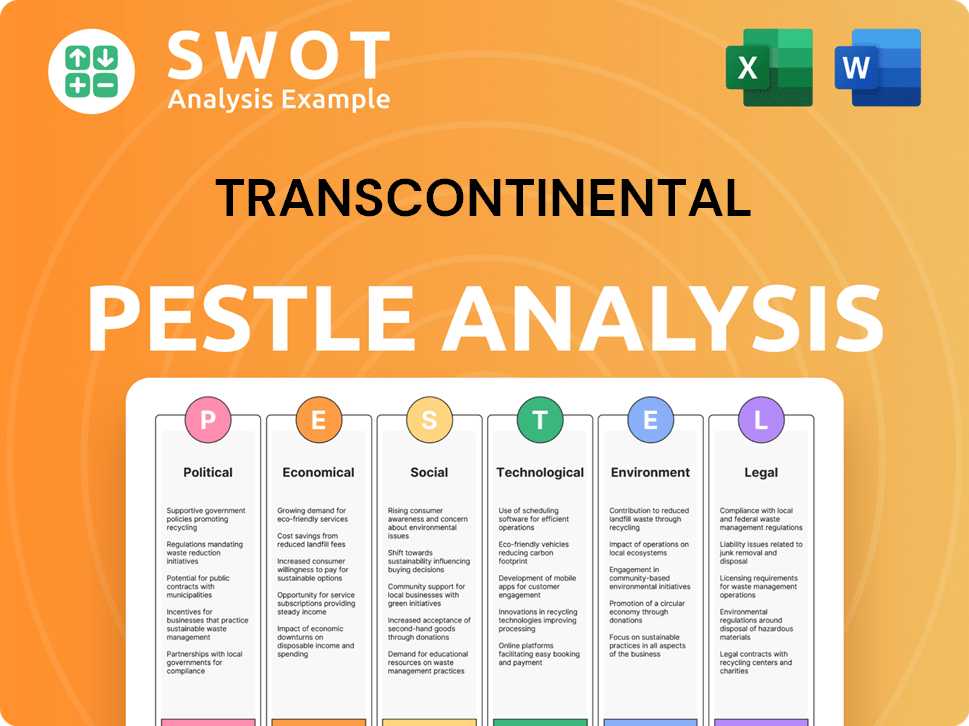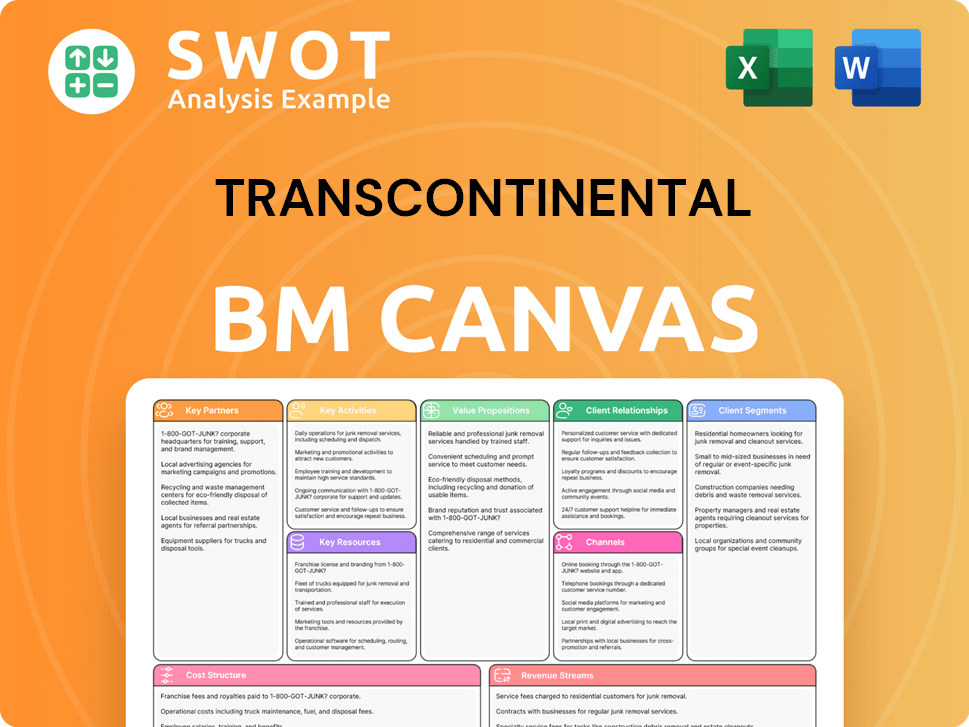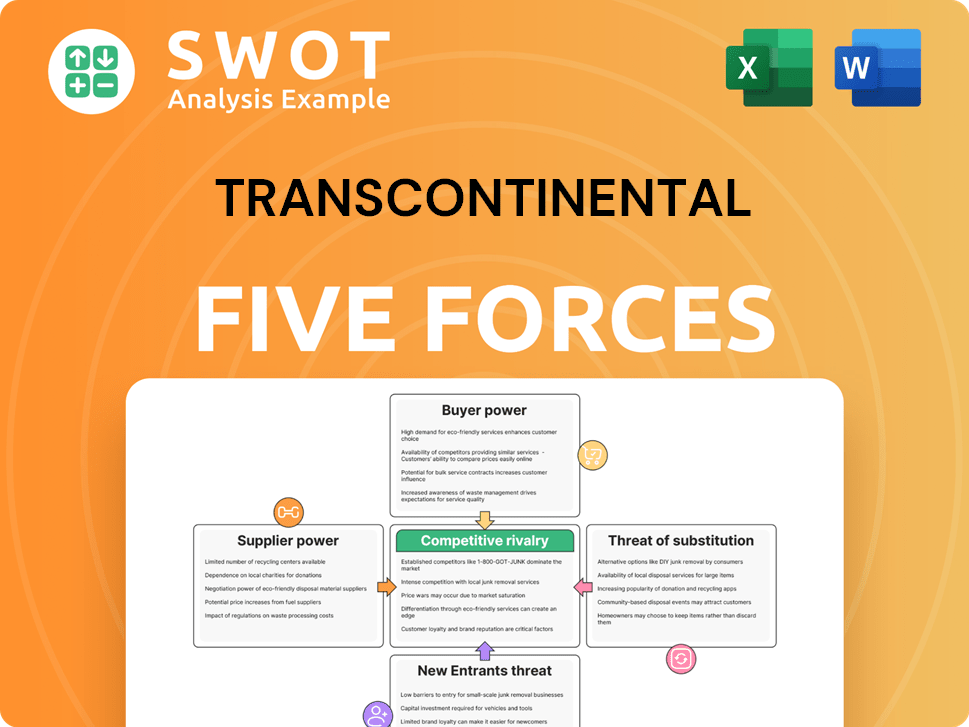Transcontinental Bundle
How Does Transcontinental Company Stack Up Against Its Rivals?
Transcontinental Company, a major player in North America's flexible packaging and printing sectors, faces a dynamic competitive landscape. Understanding its position requires a deep dive into its industry rivals and strategic moves. This analysis will explore the company's market share, Transcontinental SWOT Analysis, and the competitive advantages that define its business strategy.

This exploration of the Transcontinental Company's competitive environment will provide a comprehensive market analysis, revealing how the company navigates its challenges and capitalizes on opportunities. We'll examine Transcontinental Company's strengths and weaknesses while assessing its financial performance compared to its competitors. By understanding these key strategies, investors and strategists can gain insights into Transcontinental Company's future outlook and its ability to maintain a strong market position.
Where Does Transcontinental’ Stand in the Current Market?
The market position of the Transcontinental Company is notably strong, particularly in the North American flexible packaging sector. It is a leading supplier in this area. Furthermore, the company maintains its position as the largest printer in Canada. This dual leadership highlights its significant market penetration and strategic importance.
Transcontinental's core operations revolve around flexible packaging, commercial printing, and educational publishing. This diversified approach allows the company to serve a broad customer base across various industries. The company's value proposition centers on providing high-quality, innovative packaging solutions and printing services, tailored to meet evolving market demands and consumer preferences.
The company has strategically shifted its focus, emphasizing flexible packaging as a key growth driver. This move reflects a broader digital transformation and a diversification of offerings. This shift aligns with evolving industry trends and consumer demands, demonstrating its adaptability and forward-thinking business strategy. For a deeper dive into their expansion, check out the Growth Strategy of Transcontinental.
Specific market share figures for 2024-2025 are subject to ongoing market analysis, but Transcontinental consistently ranks among the top players in flexible packaging. In Canada, its dominance in printing is well-established. The company’s strong presence in these sectors underscores its competitive advantages.
Transcontinental's primary geographic focus is North America, with a strong base in Canada and an expanding presence in the United States, particularly through its packaging operations. This strategic focus allows the company to leverage its expertise and resources within a well-defined market.
Recent financial reports indicate a stable and scalable operation, with a focus on optimizing operational efficiencies and investing in sustainable packaging solutions. This financial stability supports its ability to compete effectively and pursue growth opportunities. For example, in fiscal year 2024, the company reported revenues of approximately $3.1 billion.
Transcontinental's key product lines include flexible packaging for various industries, commercial printing services, and educational publishing. This diverse portfolio allows the company to serve a broad customer base and mitigate risks associated with market fluctuations. The flexible packaging segment is a significant growth driver.
Transcontinental's competitive advantages include its leading market positions in flexible packaging and Canadian printing, a diversified product portfolio, and a focus on operational efficiency. These strengths enable the company to maintain a strong market position and adapt to changing industry trends. The company's commitment to sustainable packaging solutions also enhances its competitive edge.
- Leading supplier in North American flexible packaging.
- Dominant position as Canada's largest printer.
- Focus on sustainable packaging solutions.
- Strategic shift towards flexible packaging for growth.
Transcontinental SWOT Analysis
- Complete SWOT Breakdown
- Fully Customizable
- Editable in Excel & Word
- Professional Formatting
- Investor-Ready Format

Who Are the Main Competitors Challenging Transcontinental?
The competitive landscape for Transcontinental Inc. is multifaceted, encompassing various sectors where it operates. A thorough market analysis reveals that the company faces distinct challenges and opportunities depending on the specific business segment. Understanding the competitive environment analysis is crucial for assessing its strategic position and future prospects.
In the flexible packaging sector, Transcontinental competes with global giants. The Canadian printing industry presents a different set of challenges, with a mix of large and smaller players. The dynamics are constantly shifting due to technological advancements and strategic alliances.
This analysis will focus on identifying the Transcontinental Company's main competitors and how they impact its business strategy. We will also look at how Transcontinental Company is positioned within the market.
The flexible packaging segment sees Transcontinental competing with large international companies. These competitors have extensive global reach and significant R&D investments. They often compete for major contracts with consumer goods companies.
Industry rivals in flexible packaging include Amcor, Berry Global, and Mondi. These companies offer a diverse range of packaging solutions. They also focus on sustainable and innovative packaging technologies.
In the Canadian printing industry, Transcontinental faces a different set of competitors. This includes other major commercial printers and smaller regional players. Competition is fierce, especially in specialized printing services.
Transcontinental holds the largest market share in Canada's printing sector. However, competition remains strong from companies offering digital printing and competitive pricing. The educational publishing segment faces competition from other Canadian and international publishing houses.
Emerging players using advanced digital manufacturing and automation pose a threat. Mergers and alliances also reshape the competitive dynamics. Transcontinental must remain agile and responsive to these changes.
The company needs to focus on innovation and sustainability. The ability to adapt to technological advancements is crucial. Understanding the Transcontinental Company's strengths and weaknesses is vital for long-term success.
To further understand the competitive dynamics, it is helpful to consider the Transcontinental Company's market position analysis. The company's success depends on its ability to navigate these competitive challenges and capitalize on opportunities. For more insights on the Transcontinental Company's customer base and target market, you can read the article about the Target Market of Transcontinental.
To stay competitive, Transcontinental must leverage its strengths and address its weaknesses. This includes focusing on innovation, sustainability, and operational efficiency.
- Innovation: Investing in R&D to develop new packaging solutions and printing technologies.
- Sustainability: Focusing on eco-friendly materials and processes to meet evolving consumer demands.
- Operational Efficiency: Streamlining operations and reducing costs through automation and process improvements.
- Strategic Partnerships: Forming alliances with technology providers and other industry players.
- Market Expansion: Exploring new markets and expanding its product and service offerings.
Transcontinental PESTLE Analysis
- Covers All 6 PESTLE Categories
- No Research Needed – Save Hours of Work
- Built by Experts, Trusted by Consultants
- Instant Download, Ready to Use
- 100% Editable, Fully Customizable

What Gives Transcontinental a Competitive Edge Over Its Rivals?
Analyzing the competitive landscape of the Transcontinental Company reveals several key strengths. A deep dive into its business strategy shows a focus on leveraging its extensive manufacturing infrastructure and proprietary technologies. This focus allows for economies of scale and the ability to handle large volumes, critical in the flexible packaging and printing sectors. The company's market position analysis highlights its commitment to innovation and sustainability, which are significant competitive advantages.
The company's success is also rooted in its strong customer relationships and robust distribution networks. These elements contribute to stable revenue streams and efficient product delivery. Understanding the competitive environment analysis of Transcontinental, it's evident that its diversified business model provides resilience against market fluctuations. The company's ability to adapt and evolve, particularly in the flexible packaging sector, has been a key driver of its sustained performance.
Examining the competitive advantages of Transcontinental Company, it's clear that its strategic shift towards flexible packaging is a significant move. This has allowed it to leverage its operational expertise from printing to expand into a high-growth area. While industry shifts and imitation pose challenges, ongoing investments in technology and sustainability are designed to maintain these advantages. For a deeper understanding of the company's ownership structure, consider reading about Owners & Shareholders of Transcontinental.
Transcontinental's core strengths include its advanced manufacturing infrastructure, particularly in flexible packaging. This allows for efficient production and the handling of large orders. The company's brand equity, especially in Canada, fosters customer loyalty and trust.
The company's business strategy emphasizes sustainable and innovative flexible packaging solutions. Continuous investment in R&D and proprietary technologies provides a competitive edge. Transcontinental's diversified business model, encompassing flexible packaging, printing, and publishing, provides resilience.
Transcontinental maintains strong customer relationships and robust distribution networks in North America. The company's focus on flexible packaging as a high-growth area is a key strategic move. This positioning is crucial for its future outlook in the market.
Imitation and industry shifts pose threats to Transcontinental's competitive advantages. The company addresses these challenges through ongoing investments in technology, sustainability, and strategic partnerships. These strategies are essential for maintaining its market share.
In 2024, the flexible packaging market is projected to reach $350 billion globally, with a growth rate of approximately 4-5% annually. Transcontinental's focus on this segment positions it well for future growth. Its strategic emphasis on sustainable solutions aligns with increasing consumer demand for eco-friendly packaging.
- Transcontinental's revenue in 2024 is estimated to be around $3.5 billion.
- The company's investment in R&D is approximately 2-3% of its annual revenue, focusing on innovation.
- The flexible packaging segment contributes to over 60% of its total revenue.
- Transcontinental's market share in the North American printing market is around 10-12%.
Transcontinental Business Model Canvas
- Complete 9-Block Business Model Canvas
- Effortlessly Communicate Your Business Strategy
- Investor-Ready BMC Format
- 100% Editable and Customizable
- Clear and Structured Layout

What Industry Trends Are Reshaping Transcontinental’s Competitive Landscape?
The competitive environment for the Transcontinental Company is dynamic, influenced by industry trends, technological advancements, and evolving consumer preferences. A thorough market analysis reveals that the company operates in a sector facing significant shifts. Understanding the competitive landscape is crucial for assessing Transcontinental Company's market position analysis and formulating effective business strategy.
Key factors impacting the company include the rise of sustainable packaging, digital transformation, and global economic conditions. These elements shape both the challenges and opportunities for Transcontinental Company, influencing its strategic decisions and future outlook. The company's ability to adapt to these changes will determine its success in the coming years, impacting its market share and overall financial performance.
Technological advancements, such as automation and digital printing, continue to reshape the packaging and printing industries. Regulatory pressures, particularly regarding environmental sustainability, are driving the demand for eco-friendly solutions. Consumer preferences are increasingly focused on convenience, personalization, and sustainable packaging options.
The need for continuous investment in new technologies poses a significant challenge. Adapting to stricter environmental regulations and managing rising raw material costs are also key concerns. Aggressive new competitors leveraging disruptive technologies and supply chain complexities further challenge the company's position.
Significant growth opportunities exist in emerging markets for flexible packaging, particularly in sustainable and recyclable solutions. Product innovations in smart packaging, lightweight materials, and customized print solutions offer avenues for expansion. Strategic partnerships can unlock new market segments.
The company's focus on sustainable packaging, operational efficiencies, and strategic diversification will be crucial. Adapting to evolving consumer demands and technological advancements is essential. Maintaining a strong financial position and managing risks effectively are key to long-term success.
Transcontinental Company's success depends on strategic initiatives. These include expanding into sustainable packaging, optimizing operational efficiencies, and diversifying its product offerings. The company must also navigate challenges related to global supply chains and environmental regulations.
- Investing in sustainable packaging solutions to meet growing consumer demand and regulatory requirements.
- Leveraging digital transformation to enhance operational efficiency and improve customer service.
- Exploring strategic acquisitions and partnerships to enter new markets and strengthen its competitive position.
- Focusing on innovation in product development to meet evolving consumer preferences.
Transcontinental Porter's Five Forces Analysis
- Covers All 5 Competitive Forces in Detail
- Structured for Consultants, Students, and Founders
- 100% Editable in Microsoft Word & Excel
- Instant Digital Download – Use Immediately
- Compatible with Mac & PC – Fully Unlocked

Related Blogs
- What are Mission Vision & Core Values of Transcontinental Company?
- What is Growth Strategy and Future Prospects of Transcontinental Company?
- How Does Transcontinental Company Work?
- What is Sales and Marketing Strategy of Transcontinental Company?
- What is Brief History of Transcontinental Company?
- Who Owns Transcontinental Company?
- What is Customer Demographics and Target Market of Transcontinental Company?
Disclaimer
All information, articles, and product details provided on this website are for general informational and educational purposes only. We do not claim any ownership over, nor do we intend to infringe upon, any trademarks, copyrights, logos, brand names, or other intellectual property mentioned or depicted on this site. Such intellectual property remains the property of its respective owners, and any references here are made solely for identification or informational purposes, without implying any affiliation, endorsement, or partnership.
We make no representations or warranties, express or implied, regarding the accuracy, completeness, or suitability of any content or products presented. Nothing on this website should be construed as legal, tax, investment, financial, medical, or other professional advice. In addition, no part of this site—including articles or product references—constitutes a solicitation, recommendation, endorsement, advertisement, or offer to buy or sell any securities, franchises, or other financial instruments, particularly in jurisdictions where such activity would be unlawful.
All content is of a general nature and may not address the specific circumstances of any individual or entity. It is not a substitute for professional advice or services. Any actions you take based on the information provided here are strictly at your own risk. You accept full responsibility for any decisions or outcomes arising from your use of this website and agree to release us from any liability in connection with your use of, or reliance upon, the content or products found herein.